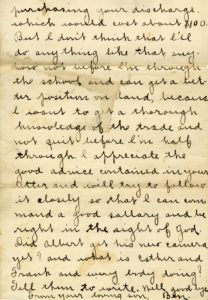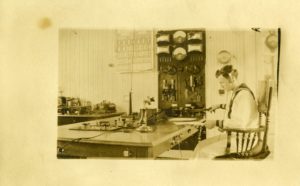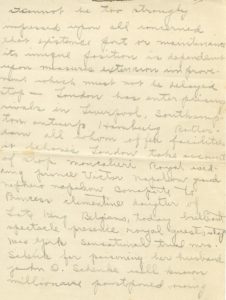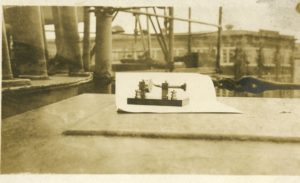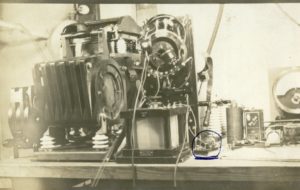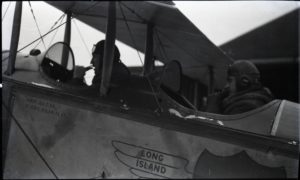In the previous two installments on inventor Benjamin Miessner, we explored his process for inventing, and the life-long feud that his inventing brought upon him. Before Miessner could invent anything, however, he needed to learn the tools of the trade. Towards this end, Miessner joined the United States Navy (hereafter referred to as the Navy), to take advantage of its free schooling and valuable experience opportunities, while saving up to attend engineering school at Purdue University. Photographs, letters home, and logs in the Benjamin F. Miessner papers provide a glimpse into the life of a wireless operator in the Navy during the early 20th century, and Miessner’s journey towards becoming an accomplished inventor. They also provide a fascinating glimpse into the experiences of an American traveling around Europe just prior to the outbreak of the 1st World War.
In 1908, Miessner left smalltown Indiana for the big city. Arriving at the Navy Electrical School in Brooklyn, New York in May, he began the 21-week program to become a wireless operator. For Miessner, joining the military wasn’t about patriotism, though he didn’t lack an appreciation for his country, but rather for the skills that this education could afford him. In a letter home to his father, Miessner discussed being able to avoid paying the discharge fee of $100 by simply not taking the examination at the end of his 21 weeks of school, should he “[get] tired of the service.” He was quick to dismiss the idea, however, stating he wanted “to get a thorough knowledge of the trade and not quit before I’m half through.”
No further correspondence with his family from 1908 survives in the collection, but several clippings from the Navy and Army Register provide a little more insight into the type of education Miessner received at the electrical school, including both images of the classroom as well as hands-on training. Miessner himself appears in the first classroom scene.
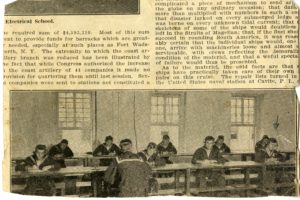
Miessner practicing wireless telegraphy at the Navy Electrical School, as seen in the Navy and Army Register, circa December 12, 1908
Come 1909, Miessner had completed his education and begun work as a wireless radio operator. By this time, he was stationed at the Navy Wireless Station in Washington, D.C., where he helped the Navy test new wireless apparatuses submitted by outside contractors for evaluation. This work allowed Miessner to network with big names in the industry, including Dr. Fritz Lowenstein, whom he would later work for. Two such individuals who figure in Miessner’s letters are Dr. Louis Austin, Inspector of Wireless Telegraphy for the Navy, and George Clark, Sub-Inspector. George Clark in particular is mentioned by Miessner as a mentor of sorts, who showed him how to conduct their tests. In his letter of November 9th, Miessner tells of learning “how to measure heights with transit,” and having measured the height of their aerial at 182 feet.
Miessner’s main duty during this time, however, was listening for and sending wireless telegraphs, as several photographs and negatives attest. In a letter to his older brother, Albert, Miessner discusses testing how far the signal from their wireless set could reach. Daily messages were exchanged with Key West, Florida, located some 1,000 miles south of Miessner’s D.C. location. San Juan, Cuba, located 1,345 miles south of his position, reportedly received his signal as well, but their return signal was not caught by Miessner. The cold, November weather and clearer morning conditions had aided in their endeavors, according to Miessner.
Working the wireless set also gave Miessner chances to brush up against “royalty.” In his November 1909 letter to Albert, Miessner mentions that the Mayflower was docked just outside his wireless station, and would be leaving that evening for Norfolk. Among its passengers would be President William Taft and First Lady Helen “Nellie” Taft, as well as Andrew Carnegie and his wife, whom Miessner expected to “get a good squint at” as they boarded the ship. Another mention of royalty comes in the form of Miessner’s scratch paper, circa 1910, which is the only example in the collection of the types of messages received by Miessner in his work. It consists of international news, including the announcement of the marriage of Prince Victor Boneparte of France to the Belgian Princess Clementine in Moncalieri, Italy.
1910 makes up the bulk of the Navy-related correspondence sent home, while also providing more insight into his activities outside of the Navy. By this time Miessner was stationed aboard the U.S.S. South Carolina, as part of the Atlantic Fleet, where he would remain until leaving the military in 1911. In November 1910, the Atlantic Fleet set sail for a tour of Europe, with the South Carolina making stops at Cherbourg in France and Portland in England. In his letters home, Miessner provides details on the fleet, including its size and the ships that made it up, the formation they traveled in, and the route they took. He also provides a detailed glimpse into the experience of traveling across the Atlantic by boat – waves twenty to thirty feet high, crashing onto the deck; utensils flying about while trying to eat; and sailor jostling into each other and trying to avoid meeting the floor face first. “Lots of fun,” Miessner noted to his father.
Miessner also discusses receiving wireless signals from land while out in the ocean, containing the day’s news – likely making mention of the scratch paper found in the same folder as the letter. According to Miessner, the cat-whisker detector he created was primarily responsible for the South Carolina being able to receive the signals. This type of detector, developed several years earlier for use on land, was not suitable for use on battleships, owing to the vibration of the ship’s engine and shock of gunfire making contact from the detector unreliable. Miessner’s detector used a spring-loaded contact, thus making it more reliable, to the point that it was later made standard equipment on all Navy installations. Photographs taken by Miessner show off his detector, as well as how it was hooked up to the South Carolina’s receiver.
After his initial letter, Miessner’s focus turns toward his explorations of Portland and Cherbourg, as well as short trips made to London and Paris during shore leave. Miessner offers an American’s perception of 1910 England and France, describing their transportation system, infrastructure, hotel accommodations, and culinary arts. He also provides cost comparisons for purchases in francs, pounds, and dollars, giving insight to the price of goods in that time, and the exchange rate for multiple currencies. In a more interesting story, Miessner tells of an incident involving a fellow sailor getting hit by a car in the streets of Paris, and gives details on the ensuing legal suit and settlement.
When contrasting the past with the present, Miessner also shows how similar the interests of a tourist from 1910 were to one in 2024. Spots he visited included the Eiffel Tower, Tomb of Napoleon, British Museum, Westminster Abbey, Winsor Castle, and Buckingham Palace. While his Paris trip followed his own itinerary, in London he made use of the services of a tourist agency, which provided the same types of guided tour that are still around today.
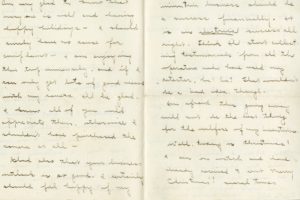
Miessner confesses to his father that his trip to Europe, while enjoyable, might not be the best for the welfare of his inventions, December 25, 1910
While Miessner enjoyed traveling around Europe and wished they “were going around the world,” his letters home also provide a reminder that his job in the Navy was never a priority for him over his dream of being an inventor. “I’m afraid this going away will not be the best thing for the welfare of my inventions,” Miessner wrote to his father from Weymouth, England. He also joked about “collecting testimonials” from all of the wireless operators who made use of his detector.
1911 opens with the Atlantic Fleet leaving Europe for Cuba, but this trip only gets a passing mention by Miessner in some 1910 letters home: “we stay [in England] three weeks, then for about three months of target practice drills, and tactical maneuvers at Guantanamo, Cuba.”[1] By April, Miessner had returned Stateside, with the South Carolina traveling up and down the New England coast, and performing speed and firing trials. In one humorous letter, Miessner tells of them losing a torpedo while training with it. The sailors spent the day diving and searching for it, only for it to show up the next morning floating some 300 yards from the ship. An attempt was made to recover it, but 75 mile per hour gales accompanied by snow and rain made the conditions at sea too rough, and the torpedo had vanished once again by the time weather conditions improved. Roughly $7,000 ($224,854 adjusted for inflation) down the toilet, by Miessner’s estimation.
The same April 1911 letter again stressed Miessner’s concern for his inventing business. He expected to be in New York a week after writing, and was planning to meet with “the Wireless Company” to discuss selling his detector. At the time he felt the financial success of his invention seemed slim, although his book “On the Early History of Radio Guidance” reveals that he ultimately succeeded in selling the patent to John Firth of the Wireless Specialty Company for $200 (about $6,500 adjusted for inflation).
The last item in Miessner’s papers related to his first tour with the Navy comes in the form of a two-page log. It briefly recaps the Atlantic Fleet’s second tour of Europe, May-July 1911, including stops in Denmark, Sweden, Russia, and Germany. No details of Miessner’s escapades in those countries are included, noting only that the visits had been “of great interest and enjoyment,” but that he was glad to be back in the U.S. A brief mention of life in the Navy is included, as the warmer weather in Cape Cod Bay compared to the Baltic Sea had allowed the sailors to switch from their blue uniforms to the “much cooler white uniforms.”
Miessner was honorably discharged from the Navy on July 27, 1911 in Provincetown, Massachusetts. After a brief stint working for John Hays Hammond, Jr. and Dr. Fritz Lowenstein, 1911-1912, Miessner achieved his goal of studying electrical engineering at Purdue University. Following his departure from Purdue, Miessner returned for a second tour in the Navy, 1916-1918, as Expert Radio Aid for Aviation. This time around, Miessner had already acquired both the education and practical experience he needed to be an inventor, so his involvement here was strictly professional in nature. His primary contribution during this period was the development of radio for communication on aircraft, including devices to mitigate the noise interference encountered, which at this time was not available in the U.S. as it was in Europe, where World War 1 was already raging. Photographs, correspondence, and notebooks in Miessner’s papers document his second tour in great detail.
The Benjamin F. Miessner papers are available for research in the Purdue University Archives and Special Collections reading room.
[1] According to the Naval History and Heritage Command, the South Carolina returned to Norfolk for repairs in January 1911, not making it to Cuba until January 1912. This may explain why Cuba does not feature again in Miessner’s letters after its first mention. (https://www.history.navy.mil/research/histories/ship-histories/danfs/s/south-carolina-iv.html#).

